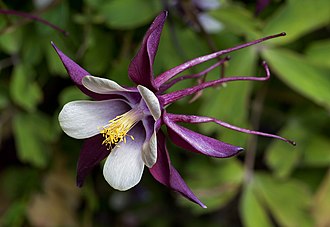Aquilegia





Aquilegia is a genus of perennial plants that are found in a variety of temperate climates around the world. Known commonly as columbines, these plants are part of the Ranunculaceae family, which also includes the likes of buttercups and anemones. Aquilegia species are well-regarded for their distinctive flowers, which have spurred petals and are often highly attractive to pollinators such as bees, butterflies, and hummingbirds.
Description[edit]
Aquilegia plants vary greatly in height, flower form, and color, depending on the species and cultivar. They typically have a bushy habit, with slender, branching stems. Leaves are biternate or triternate, with a soft, green, and sometimes bluish hue. The flowers of Aquilegia are most notable for their unique shape; they have five sepals, five petals with elongated spurs, and numerous stamens and pistils. The flowers can be blue, purple, red, yellow, white, or pink, and some species feature bi-colored blooms.
Habitat and Distribution[edit]
Aquilegia species are native to a wide range of habitats, including meadows, woodlands, and higher altitude regions in the Northern Hemisphere. They are particularly diverse in North America and Eurasia. These plants prefer well-drained soil and can be found in both full sun and partial shade environments.
Cultivation and Uses[edit]
Columbines are popular in gardens and landscapes for their ornamental value. They are relatively easy to grow from seed and can self-sow under optimal conditions, sometimes leading to naturalization in the garden. Aquilegia species are used in a variety of garden settings, including perennial borders, woodland gardens, and rock gardens. Due to their attractive flowers and ability to attract wildlife, they are also valuable in pollinator gardens.
Species and Hybrids[edit]
There are many species within the Aquilegia genus, including the European Aquilegia vulgaris and the North American Aquilegia canadensis. Hybridization, both in the wild and in cultivation, has led to a wide variety of cultivars with diverse flower colors and forms. Some popular hybrids include Aquilegia 'McKana Giants', a group known for its large, brightly colored flowers, and Aquilegia 'Swan', known for its elegant, long-spurred blooms.
Conservation[edit]
While many Aquilegia species are common and not considered at risk, habitat destruction and over-collection of wild plants have led to declines in some species. Conservation efforts are in place for certain species, focusing on habitat preservation and the regulation of plant collection.
Cultural Significance[edit]
In addition to their horticultural appeal, columbines have various symbolic meanings in different cultures. They have been associated with wisdom, strength, and courage. The flower is also a symbol for the state of Colorado in the United States.
Ad. Transform your life with W8MD's Budget GLP-1 injections from $75


W8MD offers a medical weight loss program to lose weight in Philadelphia. Our physician-supervised medical weight loss provides:
- Weight loss injections in NYC (generic and brand names):
- Zepbound / Mounjaro, Wegovy / Ozempic, Saxenda
- Most insurances accepted or discounted self-pay rates. We will obtain insurance prior authorizations if needed.
- Generic GLP1 weight loss injections from $75 for the starting dose.
- Also offer prescription weight loss medications including Phentermine, Qsymia, Diethylpropion, Contrave etc.
NYC weight loss doctor appointmentsNYC weight loss doctor appointments
Start your NYC weight loss journey today at our NYC medical weight loss and Philadelphia medical weight loss clinics.
- Call 718-946-5500 to lose weight in NYC or for medical weight loss in Philadelphia 215-676-2334.
- Tags:NYC medical weight loss, Philadelphia lose weight Zepbound NYC, Budget GLP1 weight loss injections, Wegovy Philadelphia, Wegovy NYC, Philadelphia medical weight loss, Brookly weight loss and Wegovy NYC
|
WikiMD's Wellness Encyclopedia |
| Let Food Be Thy Medicine Medicine Thy Food - Hippocrates |
Medical Disclaimer: WikiMD is not a substitute for professional medical advice. The information on WikiMD is provided as an information resource only, may be incorrect, outdated or misleading, and is not to be used or relied on for any diagnostic or treatment purposes. Please consult your health care provider before making any healthcare decisions or for guidance about a specific medical condition. WikiMD expressly disclaims responsibility, and shall have no liability, for any damages, loss, injury, or liability whatsoever suffered as a result of your reliance on the information contained in this site. By visiting this site you agree to the foregoing terms and conditions, which may from time to time be changed or supplemented by WikiMD. If you do not agree to the foregoing terms and conditions, you should not enter or use this site. See full disclaimer.
Credits:Most images are courtesy of Wikimedia commons, and templates, categories Wikipedia, licensed under CC BY SA or similar.
Translate this page: - East Asian
中文,
日本,
한국어,
South Asian
हिन्दी,
தமிழ்,
తెలుగు,
Urdu,
ಕನ್ನಡ,
Southeast Asian
Indonesian,
Vietnamese,
Thai,
မြန်မာဘာသာ,
বাংলা
European
español,
Deutsch,
français,
Greek,
português do Brasil,
polski,
română,
русский,
Nederlands,
norsk,
svenska,
suomi,
Italian
Middle Eastern & African
عربى,
Turkish,
Persian,
Hebrew,
Afrikaans,
isiZulu,
Kiswahili,
Other
Bulgarian,
Hungarian,
Czech,
Swedish,
മലയാളം,
मराठी,
ਪੰਜਾਬੀ,
ગુજરાતી,
Portuguese,
Ukrainian
